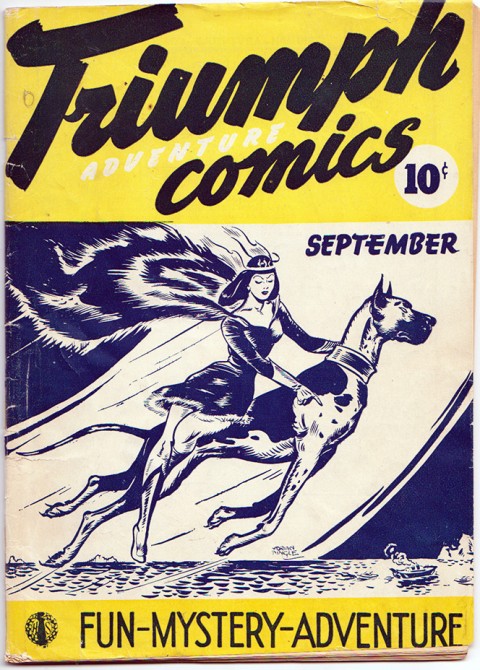
Canada Day (it was known as Dominion Day then) was also Edmond Good‘s birthday. He would have been 104 this year.
Because it’s Canada Day week I want to do a bit of a more involved special column about the figurehead of the Canadian Whites this time–Nelvana.
This mini-skirted, semi-mortal, maid of the Arctic skies has firmly become the totem (the chosen emblem) of the Canadian war-time comics. She was realized from an idea by Franz Johnson by master artist Adrian Dingle. This week I want to look at her a little more closely. My main contention is that we have probably elevated her to these heights after seven decades of maturing as a country, a culture and a comic industry when, in reality, she never had a similar popularity during the WECA period itself.
Her place in the comic book pantheon as the first real, costumed super heroine is unassailable, but she isn’t the first Canadian super-powered hero (that honour goes to Sub-Mariner clone Iron Man from Better Comics Vol. 1 No. 1 from March, 1941). Nor is she the first real costumed Canadian super hero (that honour should go to Ted Steele’s Wolf Savage from Canadian Rocket Comics No. 1 from April, 1941—Freelance, though he showed up a month before Nelvana in Triumph-Adventure Comics No. 1, really didn’t have a costume or any superpowers). After Nelvana, the first costumed super heroes to appear were Thunderfist and The Brain in Active Comics No. 1 (Feb., 1942) and the next female super heroine after Nelvana was John Hillkert’s The Wing in Joke Comics No. 4 (Sept./Oct. 1942).
But if I think of a group of young boys getting together on a park bench to discuss the comics they’ve just picked up at the corner drugstore, I don’t see them buying into Nelvana as the one to be or the one to buy the next issue for. Canadian boys then wanted to be air aces, cowboys, crime busting detectives, or futuristic space men. The media and propaganda of the day supported this. Even comic artists such as Jack Tremblay and Mel Crawford couldn’t wait to turn 18 so that they could join up and fight for Canada. The Canadian comic creators themselves were heavily influenced by the British boys-adventure literature and popular annuals and carried through that tradition in their published work in a way that the American comic creators lacked. I don’t even think that the costumed superhero genre ever took off here in war-time Canada the garish way that it did in the early forties south of the border and that while parliament kept almost all American comics out of the country, there was no sense of competition with or breaking into the American market in the sense that it permeates the Canadian comic world of today. This only entered into the Canadian war-time comic culture in its twilight when the end of the war became as immanent as the threat of American comics flooding back into the Canadian market.
If Nelvana had been so popular, why does Dingle completely take her out of a four issue arc in Triumph Comics. Nelvana disappears after the second page of the Triumph Comics No. 14 installment and doesn’t reappear until the second page of the Triumph Comics No. 18 story.
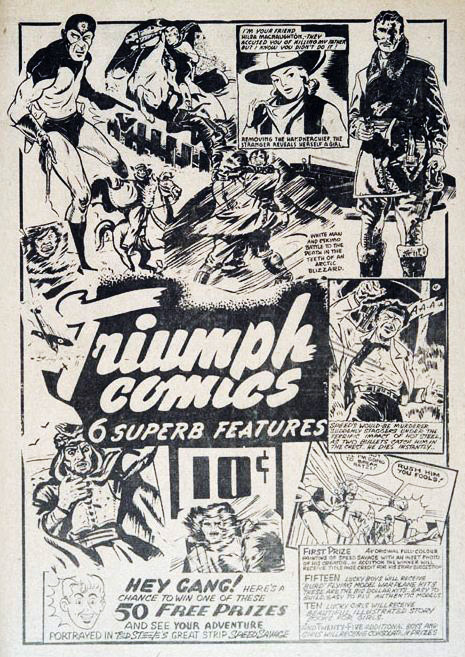
Dingle does a four issue transition from the six issue high fantasy Glacia arc that runs from Triumph 8-13 in order to anchor Nelvana into the real life Canadian battle with the axis. In this four issue arc, Dingle introduces “The Yellow Peril” into the high Arctic. It actually only takes 3 issues to do this and Dingle’s mysterious “The Mystery of the Arctic Monster” in Triumph Comics No. 17 has nothing to do with anything previous or after. The real mystery of this story is the reason as to why Dingle even included it in the Nelvana series at all, it simply fills a gap in the issue run. Perhaps Dingle was still trying to figure out how actually to bring Nelvana into the real world of Canada at war and he hadn’t come up with the idea of Alana North as a secret agent battling the axis.
Twenty years after the short run of the war-time Canadian comics, Maclean’s Magazine published an article by Alexander Ross called “A Fond Portrait of those Wild Wartime Comics” (Maclean’s Magazine Sept. 19, 1964), which is essentially an interview with Cy Bell and takes as its topic the Bell Features comics, makes absolutely no reference to Nelvana at all but has prominent pictures of Johnny Canuck, The Brain and The Invisible Commando.
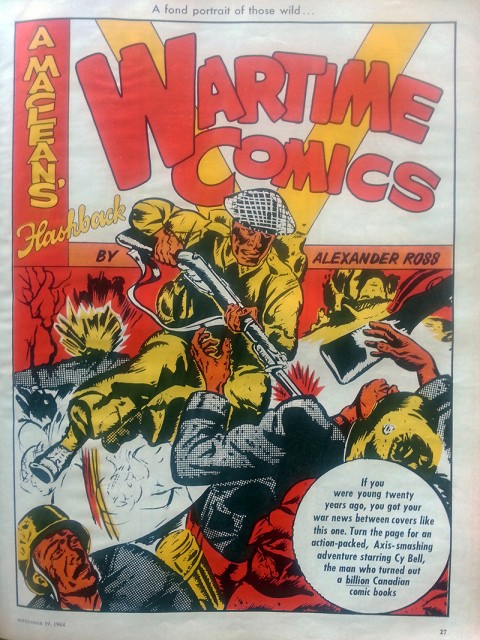
The term “Canadian Whites” wasn’t even in existence yet. It was coined by George Henderson in the late sixties. We can thank the start of Nelvana’s prominence to Clive Smith for creating the cover artwork for The Great Canadian Comic Books in 1971 and Patrick Loubert and Michael Hirsh for naming their animation company after her.
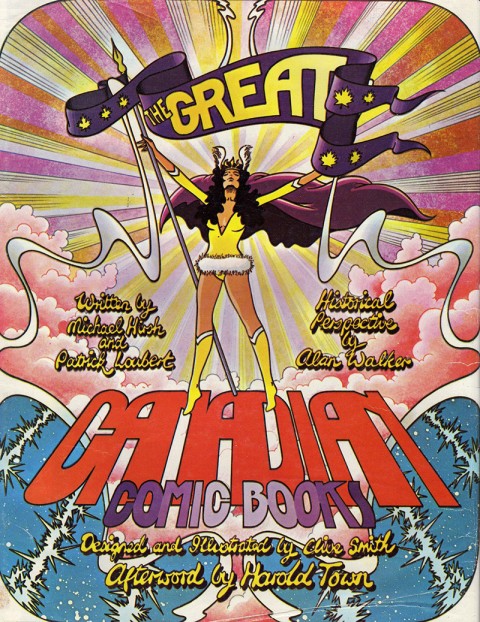
Don’t get me wrong, Nelvana did earn a 1945 compendium issue (which has become one of the most collectible comics from the period) from Bell Features which shows that she had prominence in the Bell pantheon, but so did Speed Savage, Tang the Wonder Horse, The Phantom Rider, Spike and Mike, and even a collection of the text stories from the Bell comics (a little bit later Bob Young’s Whitlecraft series received the same treatment). The fact that we’ve made Nelvana the emblem of the First Canadian Age of Comics by sifting her through the enlightened gender and McLuhan mass media consciousness that has evolved after seven decades is still sexy, but I don’t think it reflects what her actual presence was in contemporary war-time Canadian comic consciousness.
If I had to propose the most popular character from the Canadian war-time comics in a pan-Canadian sense at the actual time of the Second World War, I’d have to put Freelance up at the forefront. His stories by Ted McCall were among the best written from the WECA period. Their continuity and drama were well-mapped out and the art of Ed Furness was of the first order. Freelance had the longest page run of any WECA character, and boys could buy into him.
Robert MacMillan in his “The War Years: Anglo-American Publishing Ltd.” from John Bell’s Canuck Comics: A Guide to Comic Books Published in Canada, Matrix Books, Montreal, 1986. P. 96 refers to George Henderson, who lived through these Canadian war-time comics as a teenager, as claiming that Freelance was the most popular character in Canada during that time. Freelance, however, will never match Nelvana for fantasy sex appeal and therefore collectible value as well.
Let me also list a quick rundown of the Nelvana arcs from Triumph Comics:
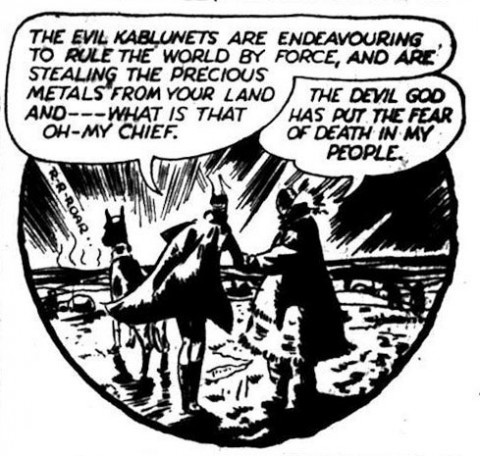
- The Kablunet Arc (Triumph-Adventure Comics Nos. 1-6 and Triumph Comics 7)
These comprise all the Hillborough issues plus the first Bell issue and the introductory story from Triumph 1 is the longest of the lot at 18 pages. It’s well-known that the seed for Nelvana was an idea brought by Dingle’s friend, Group of Seven artist Franz Johnson, after one of his trips to the north. Dingle informs us in the Dave Sim’s “A Conversation with Adrian and Pat Dingle and Bill Thomas” in the second issue of the Kitchener fanzine Now and Then Times from 1973: “The first issue is his own [Franz Johnson’s] script, actually – where I got the dialogue, what the various names were for sleds and the boots and so forth. And he did a lot of translating from Eskimo so that we could get things started. After that, I was on my own.”
We meet Nelvana, her brother Tanero and her divine father Koliak. Her first nemesis is a Slavic looking Commander Toroff, a representative of the evil Kablunets, who is depleting the northern whale population and eventually all the resources of the North in an attempt to eventually rule the world on behalf of the Kablunets. In issue 3 we find out that the Kablunets are really after the heat generating metal Zircondium 2736 and using enslaved natives to mine it. With issue 5 the Kablunets bring in their air power whose commanders all now seem to have Germanic accents and, with the help of the R.C.A.F., Nelvana defeats them. There’s even a submarine delivered Nelvana double called Mardyth thrown into the mix in issue 7.
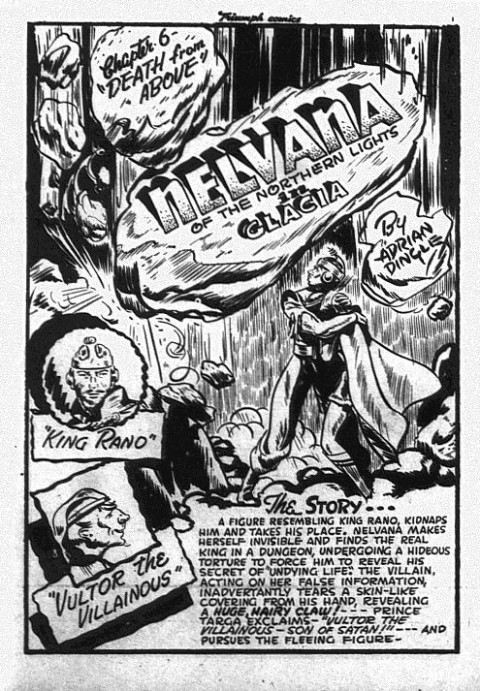
- The Glacia Arc (Triumph Comics 8-13 and Super Duper Comics No. 3)
Koliak reveals to his daughter that there has existed a frozen civilization beneath the Arctic ice for five million years with all its inhabitants in frozen suspended animation. She reanimates Targa son of King Rano and in issue 10 encounters her new nemesis, Vultor who wants to usurp the throne. In issue 11 Targa saves Nelvana from a certain death and on the last page of that issue gets her first “on screen” kiss from Targa. In issue 13 Nelvana defeats Vultor resulting in his apparent death and the return of Glacia to normality but before the chapter is over, a bomb guided by a suicidal Japanese pilot breaks through Glacia’s ceiling but doesn’t explode because of the chilly temperatures of the frozen world. The arc continues two pages into the issue 14 installment and the surface war has directly intersected Nelvana’s story line.
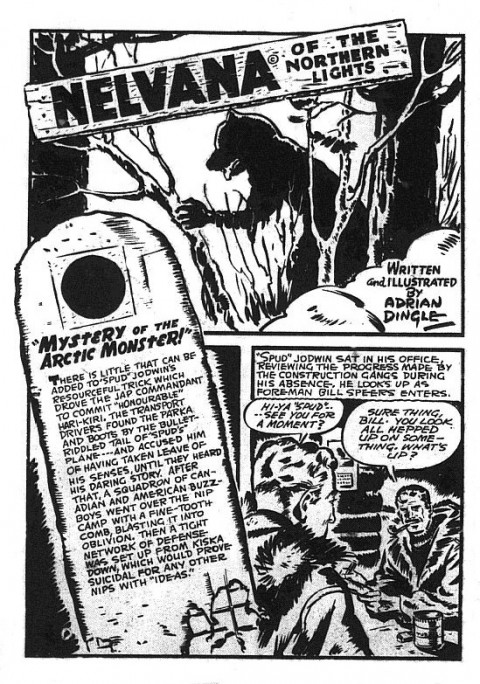
- The Transition Arc (Triumph Comics 14-17)
This arc is marked by the absence of Nelvana. In the first issue of the arc, the Japanese establish a hidden settlement in the Alaska and plot to turn Nelvana’s indigenous tribesmen against the white man. In the next two issues American engineer “Spud” Jodwin investigates the sabotage of a bridge along the Alcan (Alaska-Canada) highway and is captured by the Japanese but is eventually saved. Issue No. 16 “The Mystery of the Arctic Monster,” is the curious which really adds nothing to the Nelvana story and seems to be a filler story by Dingle while he decides what to do with Nelvana when she comes back from Glacia. “Spud” and head foreman Bill Speers solve the mystery of a strange set of tracks which are half human and half animal.
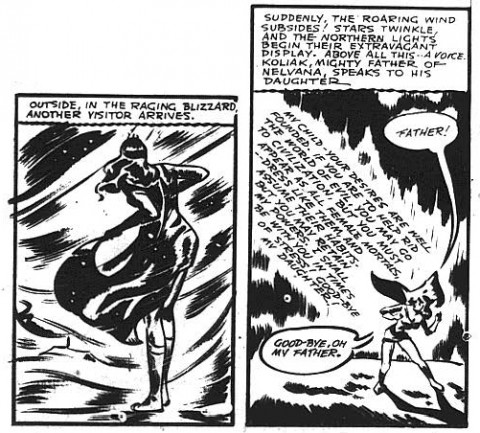
- The Return of Nelvana as Alana North and the Ice Beam Arc (Triumph Comics 18-23)
Nelvana returns to the Arctic from Glacia dramatically riding a polar bear in issue 18 and in issue 19 Koliak allows Nelvana to take on a Caucasian identity (while retaining all her powers) in order to fight the axis in the southern Ontario town of Nortonville. In issue 19 we also find out that the Langdon scientist twins Felix and Silas, both originally of Nortonville have invented an ice-beam the plans for which the Japanese salivate and send two agents, One-ear Brunner and Dwarfo after them. One-ear kidnaps Silas who has half the plans and attempts to get the remaining half from Felix but is thwarted by Nelvana as Alana. It’s important to note that Nelvana does not appear in costume again until Triumph 29 and 30 and the 1947 end of the Ether People arc in Super Duper Comics No. 3 except for the one blip in the 1945 one-shot compendium story called “Nelvana and the Death Dealing Double.”
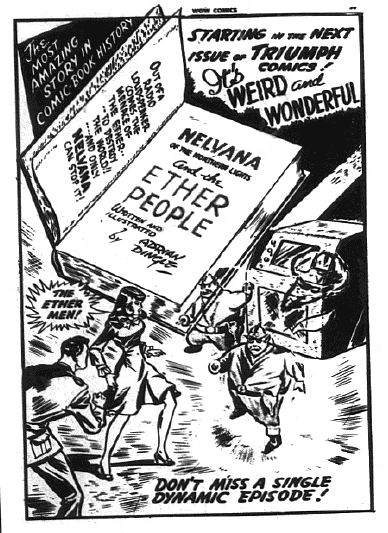
- Nelvana and the Ether People (Triumph Comics 24-29 and Super Duper Comics No. 3)
This arc brings back Corporal John Keene who we first met in Triumph-Adventure 3 and again briefly at the start of the previous arc. He encounters one of the Ethernet people who has entered our world through one of the radio speakers at the corporals northern outpost. This “emissary from the Ether world” informs Keene that human radio broadcasts have become intolerable to the Ether People and are driving them mad. He states that if they are not stopped the Ether people will destroy human civilization. These Ethernet people are short, squat individuals who remind me of Al Capp’s shmoos. Anyway, Keene tries to find Nelvana to see if she can help and in doing so travels to Nortonville where he knows he will find Silas Langdon who can possible lead him to her. He literally bumps into Alana and immediately recognizes her as Nelvana but she asks him not to give her away. Together they encounter the same Etherian and Nelvana manages to send him back through the speaker. Keene and Alana build a giant speaker that first takes them to the world of Statica which is destroyed by the discharge of atomic bomb testing on earth. They jump into the speaker again but this time they enter a new kingdom with royalty who wish to imprison her and Keene. However she saves this king and queen from an assault by “fire men” and earns their praise. But this arc ends in Triumph Comics here with the story in issue 29 with a last panel radio bulletin that the Etherian army is massing for an attack on earth and Nelvana saying that they’ve got to get to Etheria immediately. The continuation story must have been done but it took over a year to appear in F. E. Howard’s Super Duper Comics No. 3 and this time it appeared in full colour. Because of the one-year gap, the first two-and-a-half pages summarize the Nelvana saga and how she got to the point of visiting Etheria. Nelvana and Keene finally get to Etheria but are taken hostage by the Ether People and brought back to the earth as part of their invading force. There they meet the real mastermind behind this invasion, Vultor. Nelvana defeats Vultor and the Ether People return to their dimension.
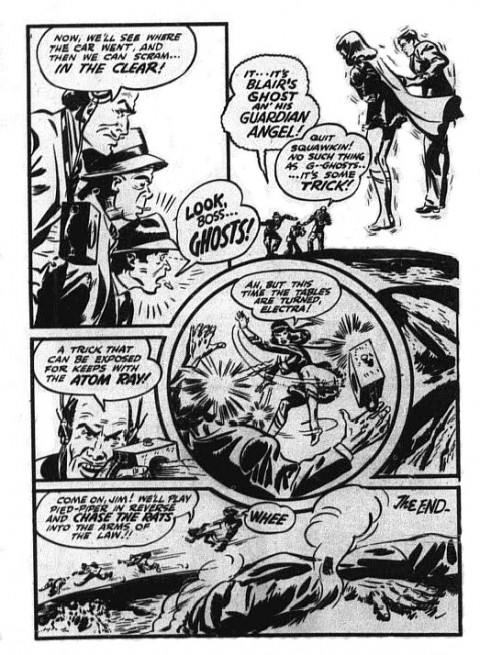
- Three Independent Nelvana Stories (Triumph Comics 30 and 31, and the 1945 Compendium)
The last two Nelvana stories in Triumph don’t belong to any arc. They are “Nelvana and the Indestructible Crime King” and “Nelvana Meets her Match.” Both involve relatively tame villains such as “Knuckles” Socco who invents a super indestructible plastic coating that prevents him from being injured and Dr. Elektra who has a contraption that discharges electrical force. Nelvana dispatches each one in 7 pages. The last story “Nelvana and the Death-Dealing Double” is the previously unpublished story from the 1945 one-shot compendium (it looks like each of these compendiums had at least one new story in it). This compendium is advertised in Triumph Comics 27, which puts its publication more than half-way through the Ether People arc but it looks like it more properly belongs just between the Ice Beam arc and the start of the Ether People Arc. It’s notable for the appearance of the criminal Nelvana double Sade and the fact that it’s the only story in which Nelvana dons her costume since she becomes Alana North in Triumph 20 until Triumph 30 after the Ether People arc finishes in that title—an almost two year run.
For another look at Nelvana please see my review of Hope and Rachel’s book at Bud Plant Books.
Without a doubt, Nelvana has become the darling of today’s collectors. I can see nothing but good in that for Canadian comics.
Before I close, I want to share an oil portrait sketch by Adrian Dingle that’s probably from the late forties or early fifties. It’s of an attractive young woman with dark hair that I whimsically like to imagine is what Alana North might have looked like in oils.

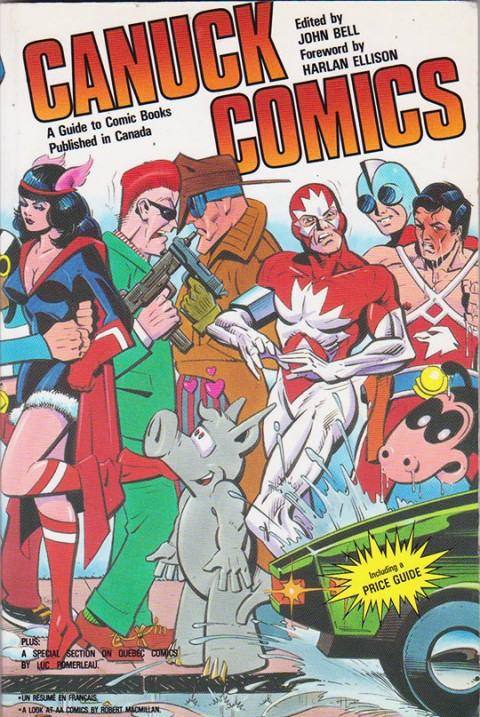
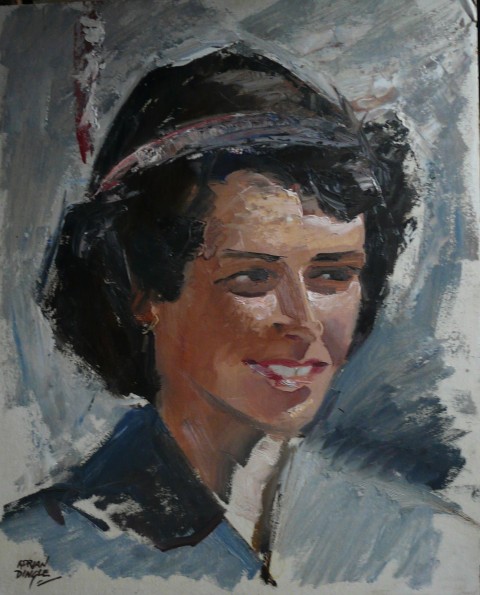
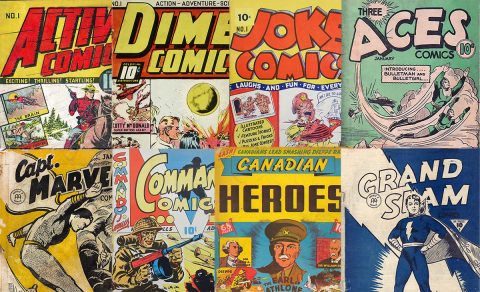
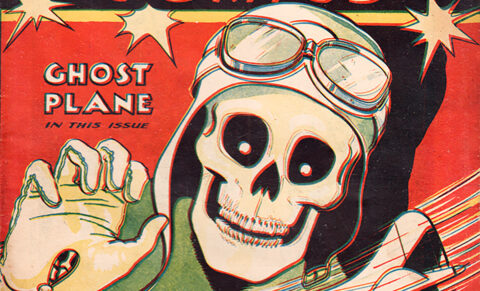
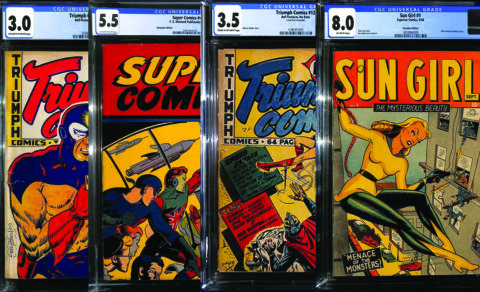
While Nelvana is the first costumed Canadian superhero, debuting in August 1941, she was preceded in American and British comics by others. Given the WECA artists’ obvious interest in American comics, there’s no doubt that part of Dingle’s inspiration would have come from seeing some of these other characters before the December 1940 passing of the War Exchange Conservation Act which prevented Canadian newsstands from getting comics and pulps.
The first heroine in comics is Sheena, the Jungle Queen (a descendant of the Tarzan tradition) arrives in British magazine Wags #1 in 1937. Her costume was a distinctive leopard skin bathing suit, but she quickly becomes a star of US-based Fiction House’s popular Jumbo Comics, in the September 1938 issue. She would be the first female character to get her own comic title in the spring of 1942, ahead of Wonder Woman. I think of all of the characters I’m going to mention, Sheena is probably the most influential, and while her strip is set in the jungles of Africa, it’s not a stretch to see a Canadian artist looking at the hinterland as the setting for a Canadian heroine to operate, and Franz Johnston’s tales providing the mystical background.
Timely’s the Black Widow (August 1940) aka Claire Voyant who appeared in the pages of Mystic Comics. She was recently revived by J. Michael Straczynski for the well-written mini-series The Twelve. She’s a bit of an antiheroine since she’s around to collect the souls of evildoers and send them to her boss, Satan. She made five appearances in The Black Widow is the first American costumed superhero but other non-costumed female adventurers predate her appearance, including the super-powered but not costumed Fantomah (in Jungle Comics #1, Feb 1940), The Woman in Red (in Thrilling Comics #2, March 1940), and Invisible Scarlet O’Neill who turned invisible in her newspaper strip which showed up in June 1940.
While she was a villain, the whip-wielding Catwoman (The Cat) arrives in Batman #1 (March, 1940). By issue #3 (September 1940) she’s wearing a fur cat mask and on her way to becoming the character we know her as now. We’ve seen WECA artists copying panels from Batman comics, so there’s no doubt that they were aware of them.
Then of course Ma Hunkel from the pages of All-American Comics became the first Red Tornado in the pages of All-American Comics #20 (November 1940), but was more of a parody of superheroes.
The newspaper strip character the Black Fury (better known as Miss Fury) debuted in April 1941 and survived until 1952. She was presented by the Bell Syndicate (not to be confused with Bell Features), and Bell Syndicate did distribute strips to Canadian newspapers during that time and the War Exchange Conservation Act did not affect newspapers. Given Dingle’s Caniff derived style it’s also worth noting that the Dragon Lady from newspaper strip (and not affected by WECA) Terry and the Pirates was an obvious inspiration for Nelvana’s spy adventures.
Other costumed superheroines that predate Nelvana but debut after the passing of the War Exchange Conservation Act are:
Bulletgirl arrives in April 1941 in the pages of Master Comics #13, however she is the companion of the already introduced Bulletman.
Hawkgirl arrives in Julyl 1941 in All Star Comics #5 (although this was probably intended as a one-off, as Shiera Saunders dons Hawkman’s spare costume, it was popular enough to warrant subsequent appearances and later a co-starring role.
Of course, Wonder Woman arrives after, in December 1941’s All Star Comics #8. Marston had been hired in early 1941 by Max Gaines to elevate the comics medium, and his wife Elizabeth suggested a female superhero was the way to go, and Wonder Woman was what resulted.
Thanks,, Kevin for this great background info on the early female comic book heroes. I only really knew about Sheena. You make a lot of excellent points about ideas that could have influenced Dingle’s creation of Nelvana. Nelvana certainly fits into this “panorama” of female comic book heroines, though she was definitely distinct from them by being the only one who wasn’t white but a mixed race.
My only feeling is that in speaking with Gerald Lazare, Jack Tremblay, and Murray Karn I never found them indicating that there was a great influence from the American comics, which all of them had come across prior to 1941. Lazare told me directly that he was influenced most by Alex Raymond and the Sunday pages, as well as the British annuals. Remember that Dingle was a fine artist first of all and had a reputation as such already. He was creating a comic book to put food on the table now that he was newly married and, as always Dingle wanted to do this with class. I don’t think he was trying to make a name for himself in comic books with Nelvana though he did want to make her a successful product. Remember that the original idea for Nelvana and the script for that whole first story was by Franz Johnson, one of the Group of Seven, who was probably very little influenced by comic book literature.
In my mind, Nelvana also has a connection to Hans Christian Andersen’s magical Snow Queen and when I saw the panels of her return from Glacia riding a polar bear (in Triumph 18, I couldn’t help thinking of Kai Nielsen’s famous drawings of the maiden riding a polar bear in his art for the Norwegian folk tale, East of the Sun and West of the Moon in the early years of the last century(a trope used again in Disney’s film The Golden Compass).
Dingle’s editorial messages (like Vernon Miller’s in the early issues of Better Comics) on the inside front covers of those early Triumph-Adventure issues also indicate that he was trying to do something different from what was going on in American comics.
I agree with you Kevin, that Nelvana can be put into one of the slots connected to and in sequence with all the female heroines you mentioned when we look back on the history of female super heroines, but I’m just trying to point out what I feel really made her distinct and Canadian.
My reply was more in response to your statement that Nelvana’s “position in the comic book pantheon as the first real, costumed super heroine is unassailable”. Insert Canadian in front of ‘comic book’ in that statement and that’s absolutely true, but on the larger stage it isn’t.
I always took the Johnston story as inspiration, not direct suggestion. Johnston was a mentor to Dingle, and I highly doubt he said “make a comic book” to him, I think Dingle was younger and, on top of that, from 1938-1941 he taught art to young people in Kitchener and Etobicoke so from them he would have been aware of the American comics and the vacuum in kids entertainment when they were taken off the table and why there was a huge opportunity for him and his Hillborough pals to fill that gap. When hearing Johnston’s stories and seeing his sketches at meetings of the art society he had his high concept.
Of course you are right, Kevin and your information about costumed heroines in comics before Nelvana is very valuable. What you say about the nature of the interaction between Johnston and Dingle is plausible, but he was friendlier with Johnston than just encountering him at art society meetings, and as I say in the text of the column, Dingle does directly say in the 1973 interview with Dave Sim in Now and Then Times that he based the entire first Nelvana story on a script with dialogue and native terminology written by Franz Johnson. Thanks for your great ideas and input Kevin.
Thanks Ivan. Sure, in the 1940s she was just another character, I suspect that’s very much true. But, as an adult reading these stories, to me, she is the most interesting character. I wouldn’t have felt that way at 5 years of age, but I feel that way now. The early nelvana stories are terrific. The later ones got a little homogenized I would argue. And, IMO, she is ultimately the flagship creation of probably the flagship creator of the whites. So, sure, she probably wasn’t anything special in the 40s to anyone except dingle. And I suspect wonder woman wasn’t anything particular special in the DC pantheon until her TV show. Ultimately, what sold best or was best received at the time is only a small part of the overall appeal of a comic IMO. If commercial appeal was the only judge of quality, Rob Liefeld’s X-Force would a freaking masterpiece LOL
Well said, Dan, but I still feel we’re zeroing in on Nelvana when there is a ton of excellent material in the span and content of the whites, quite a few better written and many whose art appeals to me more than Dingle’s which is first rate in itself, of course. But the irony is that while Nelvana probably didn’t have as great a commercial appeal in the forties as some of the other Whites characters, she’s the one that has been chosen to be reprinted first because she does indeed now have the most popularity which has slowly been manufactured and built up since the early seventies.
Sorry, I accidentally sent the last post without finishing it. I also wanted to say that yes, Nelvana has become the most iconic and popular character from the whites and she is leading the charge and is at the crest of the wave of the whites that has started to come at us out of the past, but there is so much more to discover in the whites and most people have only experienced a small tip of the iceberg that is the whites because it has been so difficult to access. But of course, I don’t think we could have chosen a better initial advertisement for the whites to the general comic readership.
I picked up the Kickstarter Nelvana book, but have yet to read it. A worthwhile project though and I think it looks great, given the age of the source materials, etc.
I’m not sure if the works are truly still under copyright in Canada though – the company that produced went out of business more than 50 years ago, and Canadian copyright doesn’t extend past that.
Regardless, I’ve also had fun using her in some art commissions alongside other Golden Age characters and more familiar faces, for example:
http://www.comicartfans.com/gallerypiece.asp?piece=999081